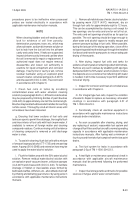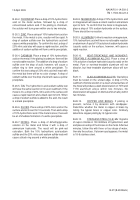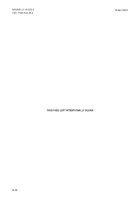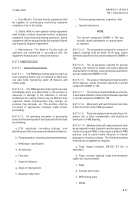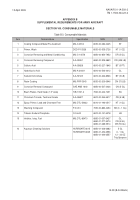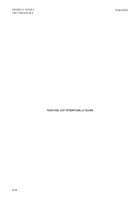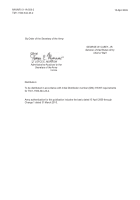TM-1-1500-344-23-2 - Page 234 of 240
B-32
NAVAIR 01-1A-509-2
TM 1-1500-344-23-2
15 April 2009
B-27.5.1.11. Masking used shall be made to adequately
withstand the blasting force, prevent media intrusion,
and protect from mechanical damage. The effectiveness
of the masking shall be verified by visual and fiber optic
inspection before approving initial production.
B-27.5.2.
Critical Parts.
B-27.5.2.1.
All parts with internal air or fluid passages
or areas that may entrap PMB media that could remain
entrapped until assembly and/or cause cross
contamination of other subsequent processing of the
end item, will be masked to prevent media intrusion.
B-27.5.2.2.
Thoroughly clean excess PMB media from
the parts by vacuuming or blowing with dry/filtered
compressed air before removing the masking. Then
vacuum or blow air through the internal passages to
remove any entrapped media.
B-27.5.2.3.
Flush with solvent or detergent as required
by the applicable aircraft component DMWR or TM to
clear internal passages.
B-27.5.2.4.
FSP with Critical Inspection Points shall
be Fiber Optic inspected after PMB, cleaning, and
flushing, and evidence of the inspection shall be
maintained on file.
B-27.5.3.
Soft Metal Parts.
B-27.5.3.1.
Unless otherwise specified in the aircraft
component DMWR or TM, aluminum and magnesium
parts shall only be stripped to the primer layer applied
to the anodized or chemical surface treatment. They
may exhibit a haze of primer after stripping.
B-27.5.3.2.
Magnesium parts coated with Rock Hard®
resin coating or MIL-R-3043 resin coatings shall be
stripped only to the resin coatings if subsequent penetrant
inspection is required.
B-27.5.3.3.
If the chemical conversion coating,
anodize, or resin coating has been completely removed
exposing the bare metal substrate, etching to remove
flowed metal shall be required after PMB and before
NDI. Refer to applicable aircraft component DMWR or
TM for etching chemicals and process. The chemical
conversion coating, anodize, or resin coating shall be
re-applied before re-painting.
B-27.5.4.
Titanium Parts. Titanium parts may be
stripped to bare metal. Any chemical conversion coatings
or soft metal platings removed shall be re-applied.
B-27.5.5.
Ferrous Parts. Ferrous alloy parts may be
stripped to bare metal if these are not cadmium plated.
Any chemical conversion coatings or soft metal platings
removed shall be re-applied.
B-27.5.6.
Non-Metal Parts.
B-27.5.6.1.
Non-metal surfaces may be stripped to
the primer layer. The lowest effective air pressure
setting should be used to avoid damaging the surface.
B-27.5.6.2.
A rough haze or exposed fibers is
unacceptable.
B-27.5.7.
Post Processing.
B-27.5.7.1.
All parts blasted by PMB shall be
thoroughly cleaned by blowing with dry/filtered air or
vacuuming. If masking was applied, masking shall not
be removed prior to blowing with air. Other media
cleaning methods, such as ultrasonic cleaning or solvent
flushing, may be used as per the applicable aircraft
component DMWR or TM.
B-27.5.7.2.
After removing the masking, clean the
part per the applicable aircraft component DMWR or TM
to remove lingering PMB media and masking residue.
B-27.5.7.3.
Parts susceptible to corrosion that have
been stripped to bare metal shall be coated with a
corrosion preventive compound if subsequent
processing is delayed.
B-27.6. TRAINING
AND
CERTIFICATION
REQUIREMENTS. Personnel performing and
supervising media blasting of organic coatings from
aircraft component surfaces shall complete a training
program leading to certification. An AMCOM authorized
source shall be used for the initial training and
certification. Operators shall be re-certified every two
years.
Back to Top


